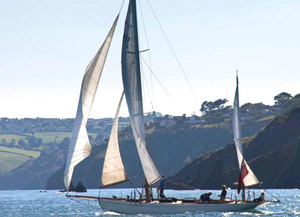Saunterer gives up her secrets – Part 4 – original scribe lines discovered
Date: 20th July, 2015
“As we have stripped back all the paint on the hull we have also discovered three “scribe lines” at different levels (lines scribed by her architects round her hull to show precisely where she should lie on her waterline). All three scribe lines are lower on her hull than her existing waterline – suggesting that her hull should actually lie further out of the water than it is.
The pictures below show the stripped back hull – from the stern…
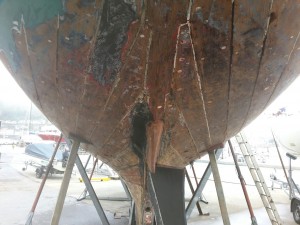
and from the bow…

…and when we put her back in the water for a brief floation test to see where she lies on her lines, Saunterer has risen out of the water above her original scribe lines by about 6 inches.
This is logical because (a) she is drier throughout, and we have removed (b) all the concrete and tar from her bilge (weighing about 750kg to date) and (c) her engine and fuel and water stocks (about 500kg). The pictures below show the floatation test (note the bungs in the hull)…
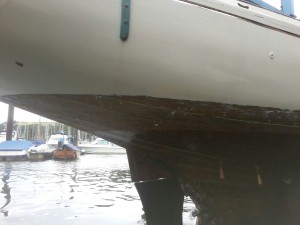
… and the wetted area above her rudder does not reach the white paint of the hull…
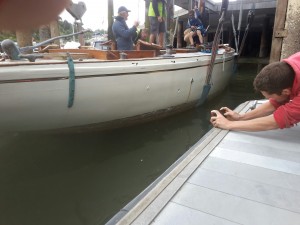
she is lying about 6 inches out of the water…
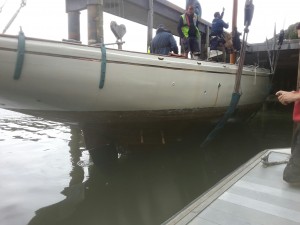
…also shown by the wetted area on her hull as she is lifted out again.
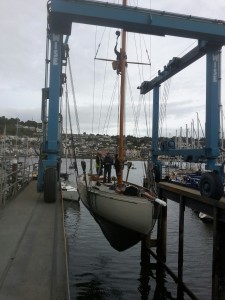
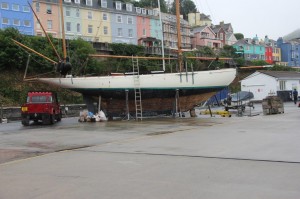
Some overall appreciation of her lines is offered by these pictures”
The Project Team – 20 July 2015
Saunterer gives up her secrets – Part 3 – copper banding lines
Date: 15th July, 2015
“Unlike almost any other thing, the hull of a wooden boat conceals under its paint many of its secrets – the life of the boat itself. Here in Darthaven Marina in Dartmouth you could be forgiven for thinking this is another wooden hull going through her ritual and necessary upgrading and restoration.
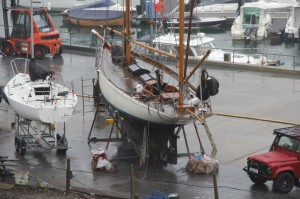
And indeed the port side …
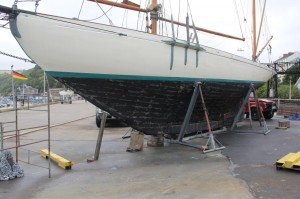
and the starboard side of the hull…
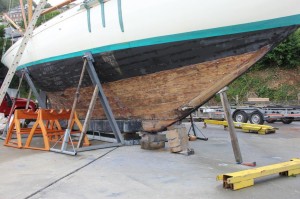
show much of her life story. A closer inspection shows some of her history of restoration by previous generations…

but this picture…
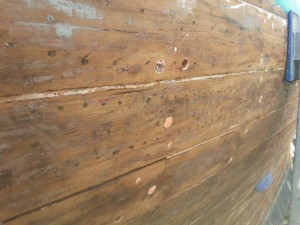
…reveals the nail holes of a strip of copper banding along her waterline – long since removed – which would only have been positioned in preparation for ice – perhaps for her Baltic cruise in the late 1940s, after which her gaff rig was replaced by her existing bermudan rig.”
The Project Team – 15 July 2015
Views of the interior – for and aft – July 2015
Date: 15th July, 2015
After much of the initial clearance work has been done – views of Saunterer’s interior – Looking forward…

and aft…

The Projct Team – July 2015
Saunterer now ready to remove her floors
Date: 13th July, 2015
This picture shows how immensely strong Saunterer’s construction was – with sawn oak timbers making up her frames – in some cases three deep, jointed by wooden pegs which could flex and expand as the hull came together – and the natural limitations of the shape of the oak frames overcome by the selection of more than one timber to form the hull shape required…
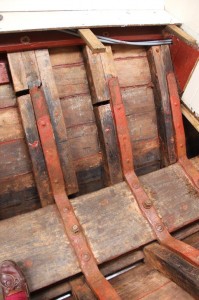
…now we see the limber holes providing drainage at the lowest part of the bilge when the hull is taken out of the water – with wooden plugs covered over with copper patches (tingles) on the outside of the hull when launched…
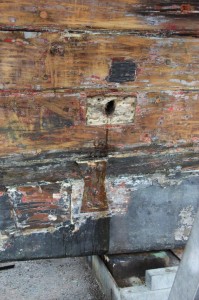
…above you can also see the aft “dovetail plate” connecting the lead keel to the keel itself – which stops the keel twisting – these plates were positioned on both sides of the keel, for and aft with bronze rods connecting the starboard and port plates in each case…
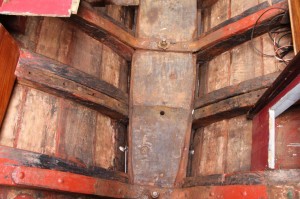
…and here you can see the limber holes draining from the lowest part of the hull interior from each side of the keel.
We believe this view of Saunterer’s interior construction has not been seen so clearly for over 100 years…
Removing the first iron floor – July 2015
Date: 12th July, 2015
The process begins with clearing debris from the area around the floor…

and then removing the keel bolt nut, and grinding out the inboard end of the retaining rivets which fasten the floor through both the oak frame and the teak of the hull itself…

the rivets are then very carefully tapped from inside to back them out of the hull to avoid damage…

…which becomes clear when shown as a whole assembly (the floor removed from inside the hull, and the rivets laid across it).

An immensely strong assembly when in position…

… as seen in this view from outside the hull showing where the rivets have been removed – a total of 8 rivets (including both sides) and one keel bolt.
A view of the interior – July 2015
Date: 7th July, 2015
…Much of the debris of concrete and tar has been removed from Saunterer’s bilge to reveal the interior shape of the hull and floors – with some degrading of the floors evident…

and the keel bolt nuts beginning to be carefully turned…
Saunterer gives up her secrets – Part 2 – cross section of her hull
Date: 5th July, 2015
“Here is a 1899 drawing of Saunterer’s hull entitled, “Midship Section of 16 ton Fast Cruiser” – effectively a cross-section amidships. It is dated 22 November, about 4 months before she was launched on 27 March 1900.

A closer look at the detail around the keel shows a single piece of English elm – with no keelson to reinforce – and the vertical bronze bolts and iron floors holding the lead ballast keel fast to the elm keel…

Initially we thought that this construction has not been modified. However, after the work to remove the concrete and tar from the bilge was complete, the team checked as they went along for any variation and it became clear that there is in fact a teak keelson sitting on top of the elm keel – which “is as hard as rock!” – and fastened by a zig zag pattern of bolts riveted at each end along its length, making the overall construction incredibly strong.
This occupies the narrower upper part of the cross section of the keel shown in the original drawing above. That is an interesting secret.
The Project Team – 5 July 2015 and revised in March 2016
[ssba]
